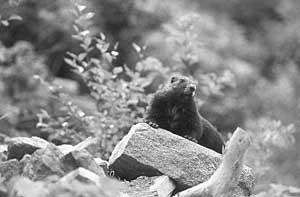Construction on a Marmot Breeding Centre at Mt.Washington was slated to begin in October, to provide a new home for a captive breeding program for the endangered animals. And the need has never been so urgent, says Tony Barrett of the Marmot Recovery Foundation.
“We put 43 animals to bed a year ago (December). Only 25 came up,” Barrett said. “Seventeen animals died over the winter last year.” Just 50 marmots were counted in June on the entire Island, including several from a colony on Mt.Washington.
“We’ve never been more tense,” Barrett said. “The anxiety was palpable, because it’s extinction that is happening before our very eyes.” Crews already laid the foundation and walls for the building but, as no official announcement had been made about construction, Barrett declined to discuss the project. He said he preferred to wait until the foundation makes its big splash in the coming months. The building is located within sight of the summit of the Eagle Express quad chairlift, where the Mt.Washington marmot colony lives.
This past spring about 12 marmots were known to inhabit Mt.Washington, including four new pups. Not very encouraging numbers. But volunteers are optimistic about the captive breeding program; last spring, eight marmot pups were born in captivity at the Calgary Zoo, and roughly the same amount in a similar program at the Toronto Zoo. Zookeepers excitedly listened to squeaks coming from a nesting box last spring, and waited several weeks before the mother marmot debuted her offspring.
Two years ago the program looked less hopeful, Barrett said. At that time, the Marmot Recovery Foundation was wondering if captive breeding was a viable alternative to help save the rapidly dwindling species. Despite the losses, there is light at the end of the tunnel. “This is the first time in 20 years that the population hasn’t declined, but has held level,” Barrett said. “Maybe it’s a watershed year for us.”
The new breeding centre will have 20 marmot enclosures, each capable of maintaining a breeding pair or family group. They will have access to both indoor and outdoor areas; inside, they will be provided with marmot “cage furniture”: nest boxes, tunnels, perches and other structures that give them a chance to chew and climb, just like they were in the wild. “Building a facility on Mt.Washington allows us to maintain captive marmots on a normal seasonal cycle and to expose them to natural temperatures, light conditions and food,” captive breeding specialist
Dr. Malcolm McAdie wrote in an issue of The Marmot Recovery Foundation’s newsletter, The Marmoteer.
“Thanks to the proximity of the ski hill, building a facility on Mt.Washington provides us with the road access and power that we will need to take care of the captive marmots throughout the year ? even hibernating marmots will require monitoring and care during the winter.”
Designing the facility has required the integration of engineering, animal husbandry and marmot biology, McAdie said. The building had to be designed to withstand heavy snow loads while at the same time supporting the delicate physiological demands of hibernating marmots. Although the building will not be open to the public, foundation members are hoping to be able to offer viewing and host education programs. Until then, they will collectively cross their fingers that the species will not die out.
“We’re a long way from recovering the species,” Barrett said, “but we have a plan, we’re acting upon it and it’s beginning to show it’s worth it.”
